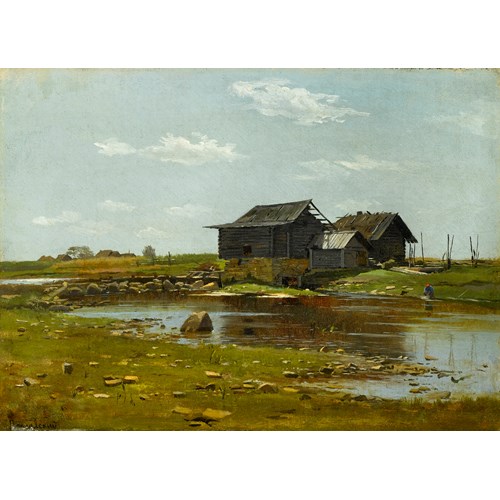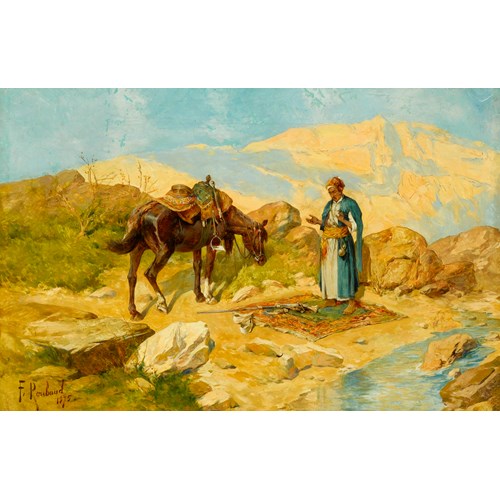Willem van Mieris
The Penitent Mary Magdalene
Date 1709
Epoque 1600-1750, 18th century
Origine The Netherlands
Medium Oil on panel
Dimension 20.3 x 16.2 cm (8 x 6³/₈ inches)
Willem van Mieris was perhaps the principle figure in the last generation of the fijnschilders, a group of painters based in Leiden who specialised in small scale pictures, filled with detail and defined by miniaturistic precision and refinement of technique. The two leading fijnschilders of the previous generations were Gerrit Dou (1613-1675), and Willem’s father, Frans van Mieris (1635-1681). The Penitent Mary Magdalene demonstrates that Willem had inherited the polished technique, and passion for meticulously rendered detail, that characterised the work of these masters. The foreground is a range of contrasting textures, such as the tough, battered leather of the book, against the cold stone ledge, and these surfaces are rendered with the same painstaking care as the tear-stained puffiness of Mary’s eyes.
Dr Junko Aono has recently determined that The Penitent Mary Magdalene once had a pendant in the form of the Leiden Collection’s Hermit Praying in the Wilderness.¹ The earliest mention of both paintings, in 1747, records that they were a pair.² Although Hermit Praying is dated two years earlier than Mary Magdalene, the works are clearly complementary. Both sitters are in similar rocky landscapes, and the way Mary turns her head towards the crucifix connects that painting to its pendant. In addition to the similar setting, in both paintings van Mieris has included the same crucifix, leather-bound book, and skull.
Mary Magdalene was a subject van Mieris returned to repeatedly over his career. In addition to our painting, Cornelis Hofstede de Groot lists five other treatments of the theme, and at least two drawings are known of.³ It seems plausible that these paintings were intended for Catholic patrons, ‘although the sensuous aspects of the theme were apparently what made it so appealing to so many Baroque artists’.⁴ The emotion intrinsic to the Magdalene narrative would also have appealed to van Mieris, whose history paintings are full of theatrical gestures.
The Penitent Mary Magdalene is a typical example of van Mieris’ work, and a fine representation of what made his paintings so popular. Although his portraits are highly individualised, in his genre and history paintings, women tend to be idealised, with ‘almost identical faces, proportions, hairstyles, beautiful skin and décolleté, and graceful gestures with their arms, hands and fingers’.⁵ This is evident when comparing Mary Magdalene to another work of the same year, Lot and his Daughters, which again is set in a rocky landscape.⁶ In this larger work, although there are three figures, van Mieris clearly focuses the viewer’s attention onto the daughter on the right of the composition, who is the same ‘type’ as Mary. Both figures turn their bodies and have an almost sculptural quality, due to their poses, porcelain skin and dramatic lighting. This woman is used repeatedly by van Mieris throughout his career, especially after he had come into contact with the ivory sculptures of Francis van Bossuit (1635-1692), from whom he ‘directly borrowed poses and gestures’.⁷
Willem van Mieris, like his brother Jan (1660-1690), trained in Leiden as a painter under the tutelage of their illustrious father Frans. Willem’s highly refined application of paint and attention to detail, evident in The Penitent Mary Magdalene, are a direct result of the influence of Frans, as well as Gerrit Dou. Frans died suddenly in 1681, and it seems likely that Willem and Jan took over the workshop. Willem’s first dated works come shortly after, in 1682, and the following year he was elected to the Leiden Guild of St. Luke.
Willem’s status as one of Leiden’s leading painters is reflected by the fact that he served was elected as the dean of the Guild of St. Luke in 1699, in addition to the post of hoofdman (leader), a further four times. However, he also founded the Leiden Tekenacademie (drawing academy), with his fellow artists Carel de Moor (1655-1738) and Jacob Toorenvliet (1640-1719).
By the beginning of the eighteenth century, van Mieris had firmly established his reputation, and was enjoying great success. In 1705 he was able to buy a house on the elegant Breestraat, and his work was much in demand, despite the high prices he was able to charge. Naturally he was much sought after by Leiden’s leading collectors, most notably the cloth manufacturer Pieter de la Court van de Voort. However, van Mieris was also collected by several foreign collectors, such as The Archbishop of Mainz and Elector of the Holy Roman Empire, Lothar Franz von Schönborn (1655-1729), and Duke Anton Ulrich von Braunschweig-Wolfenbüttel (1633-1714). He was one of the most famous painters of his time, until the 1730s, when his sight began to fail, and as a result the quality of his works decreased.
¹ Aono, J., ‘Hermit Praying in the Wilderness’, in The Leiden Collection Catalogue. Edited by Arthur K. Wheelock Jr. New York.
² Jacques de Roore (1686-1747), sale, The Hague, 4 September 1747, nos. 104 & 105.
³ Hofstede de Groot, C., Beschreibendes und kritisches Verzeichnis der Werke der hervorragendsten Holländischen Maler des XVII Jahrhunderts, vol. X (Stuttgart/Paris, 1928), pp. 115-116, nos. 32-37. For the drawings see British Museum, London, inv. no. 1862,0614.1277; & Leiden University Libraries, Leiden, inv. no. PK-2014-T-7.
⁴ Baer, R., ‘The Life and Art of Gerrit Dou’, in Gerrit Dou 1613-1675: Master Painter in the Age of Rembrandt, exh. cat. (Washington, National Gallery of Art 2000) p.49.
⁵ Aono, J. Imitation and Innovation: Dutch Genre Painting 1680-1750 and its Reception of the Golden Age (PhD. Thesis, University of Amsterdam, 2011), p.114.
⁶ Sotheby's, New York, 24 January 2008, lot 319.
⁷ Aono 2011, p. 110.
Date: 1709
Epoque: 1600-1750, 18th century
Origine: The Netherlands
Medium: Oil on panel
Signature: Signed and dated ‘W. Van/Mieris/Fe/1709’ (upper left).
Dimension: 20.3 x 16.2 cm (8 x 6³/₈ inches)
Provenance: Jacques de Roore (1686-1747);
his sale, The Hague, 4 September 1747, no. 105 (fl. 153, together with no. 104, St. Jerome, as its pendant, to Van Spangen);
John van Spangen, his sale, London, 12 February 1748, no. 74 (£20.9, together with no. 73, St. Jerome, as its pendant);
Philippus van der Land;
his sale, Amsterdam, 22 May 1776, no. 54 (for 180 florins, together with no. 55, St. Jerome, as its pendant);
Caroline Anne, 4th Marchioness Ely, Eversly Park;
her posthumous sale, Christie's, London, 3 August 1917, no. 46;
with Cyril Andrade, London;
Henry Blank (1872-1949), Newark, USA, by 1926,;
his posthumous sale, Parke-Bernet, New York, 16 November 1949, lot 2;
anonymous sale, Parke-Bernet, New York, 8 April 1950, lot 42;
anonymous sale, Piasa, Paris, 13 June 1997.
Literature: Cornelis Hofstede de Groot, Beschreibendes und kritisches Verzeichnis der Werke der hervorragendsten Holländischen Maler des XVII Jahrhunderts, vol. X (Stuttgart/Paris, 1928), p. 116, no. 37 (with the incorrect dimensions).
Plus d'œuvres d'art de la Galerie









